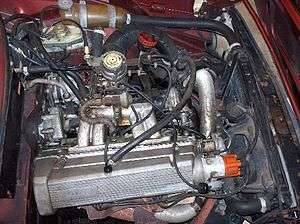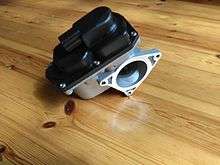Exhaust gas recirculation
In internal combustion engines, exhaust gas recirculation (EGR) is a nitrogen oxide (NO
x ) emissions reduction technique used in petrol/gasoline and diesel engines. EGR works by recirculating a portion of an engine's exhaust gas back to the engine cylinders. This dilutes the O2 in the incoming air stream and provides gases inert to combustion to act as absorbents of combustion heat to reduce peak in-cylinder temperatures. NO
x is produced in high temperature mixtures of atmospheric nitrogen and oxygen that occur in the combustion cylinder, and this usually occurs at cylinder peak pressure. Another primary benefit of external EGR valves on a spark ignition engine is an increase in efficiency, as charge dilution allows a larger throttle position and reduces associated pumping losses.

In a gasoline engine, this inert exhaust displaces some amount of combustible charge in the cylinder, effectively reducing the quantity of charge available for combustion without affecting the air : fuel ratio. In a diesel engine, the exhaust gas replaces some of the excess oxygen in the pre-combustion mixture.[1] Because NO
x forms primarily when a mixture of nitrogen and oxygen is subjected to high temperature, the lower combustion chamber temperatures caused by EGR reduces the amount of NO
x the combustion generates. Gases re-introduced from EGR systems will also contain near equilibrium concentrations of NO
x and CO; the small fraction initially within the combustion chamber inhibits the total net production of these and other pollutants when sampled on a time average. Chemical properties of different fuels limit how much EGR may be used. For example methanol is more tolerant to EGR than gasoline.[2]
History
The first EGR systems were crude; some were as simple as an orifice jet between the exhaust and intake tracts which admitted exhaust to the intake tract whenever the engine was running. Difficult starting, rough idling, and reduced performance and fuel economy resulted.[3] By 1973, an EGR valve controlled by manifold vacuum opened or closed to admit exhaust to the intake tract only under certain conditions. Control systems grew more sophisticated as automakers gained experience; Volkswagen's "Coolant Controlled Exhaust Gas Recirculation" system of 1973 exemplified this evolution: a coolant temperature sensor blocked vacuum to the EGR valve until the engine reached normal operating temperature.[3] This prevented driveability problems due to unnecessary exhaust induction; NO
x forms under elevated temperature conditions generally not present with a cold engine. Moreover, the EGR valve was controlled, in part, by vacuum drawn from the carburetor's venturi, which allowed more precise constraint of EGR flow to only those engine load conditions under which NO
x is likely to form.[4] Later, backpressure transducers were added to the EGR valve control to further tailor EGR flow to engine load conditions. Most modern engines now need exhaust gas recirculation to meet emissions standards. However, recent innovations have led to the development of engines that do not require them. The 3.6 Chrysler Pentastar engine is one example that does not require EGR.[5]
EGR
The exhaust gas, added to the fuel, oxygen, and combustion products, increases the specific heat capacity of the cylinder contents, which lowers the adiabatic flame temperature.
In a typical automotive spark-ignited (SI) engine, 5% to 15% of the exhaust gas is routed back to the intake as EGR. The maximum quantity is limited by the need of the mixture to sustain a continuous flame front during the combustion event; excessive EGR in poorly set up applications can cause misfires and partial burns. Although EGR does measurably slow combustion, this can largely be compensated for by advancing spark timing. The impact of EGR on engine efficiency largely depends on the specific engine design, and sometimes leads to a compromise between efficiency and NO
x emissions. A properly operating EGR can theoretically increase the efficiency of gasoline engines via several mechanisms:
- Reduced throttling losses. The addition of inert exhaust gas into the intake system means that for a given power output, the throttle plate must be opened further, resulting in increased inlet manifold pressure and reduced throttling losses.[6]
- Reduced heat rejection. Lowered peak combustion temperatures not only reduces NO
x formation, it also reduces the loss of thermal energy to combustion chamber surfaces, leaving more available for conversion to mechanical work during the expansion stroke. - Reduced chemical dissociation. The lower peak temperatures result in more of the released energy remaining as sensible energy near Top Dead Center (TDC), rather than being bound up (early in the expansion stroke) in the dissociation of combustion products. This effect is minor compared to the first two.
EGR is typically not employed at high loads because it would reduce peak power output. This is because it reduces the intake charge density. EGR is also omitted at idle (low-speed, zero load) because it would cause unstable combustion, resulting in rough idle.
Since the EGR system recirculates a portion of exhaust gases, over time the valve can become clogged with carbon deposits that prevent it from operating properly. Clogged EGR valves can sometimes be cleaned, but replacement is necessary if the valve is faulty.
In diesel engines

In modern diesel engines, the EGR gas is cooled with a heat exchanger to allow the introduction of a greater mass of recirculated gas. Unlike spark-ignition engines, diesels are not limited by the need for a contiguous flamefront; furthermore, since diesels always operate with excess air, they benefit from EGR rates as high as 50% (at idle, when there is otherwise a large excess of air) in controlling NO
x emissions. Exhaust recirculated back into the cylinder can increase engine wear as carbon particulates blow by the piston rings and into the oil.[7]
Since diesel engines are unthrottled, EGR does not lower throttling losses in the way that it does for SI engines. Exhaust gas—largely nitrogen, carbon dioxide, and water vapor—has a higher specific heat than air, so it still serves to lower peak combustion temperatures. However, adding EGR to a diesel reduces the specific heat ratio of the combustion gases in the power stroke. This reduces the amount of power that can be extracted by the piston. EGR also tends to reduce the amount of fuel burned in the power stroke. This is evident by the increase in particulate emissions that corresponds to an increase in EGR.[8][9]
Particulate matter (mainly carbon) that is not burned in the power stroke is wasted energy. Stricter regulations on particulate matter (PM) call for further emission controls to be introduced to compensate for the PM emission increases caused by EGR. The most common is a diesel particulate filter (DPF) in the exhaust system which cleans the exhaust but causes a constant minor reduction in fuel efficiency due to the back pressure created. The nitrogen dioxide component of NO
x emissions is the primary oxidizer of the soot caught in the DPF at normal operating temperatures. This process is known as passive regeneration. Increasing EGR rates cause passive regeneration to be less effective at managing the PM loading in the DPF. This necessitates periodic active regeneration of the DPF by burning diesel fuel in the oxidation catalyst in order to significantly increase exhaust gas temperatures through the DPF to the point where PM is quickly burned by the residual oxygen in the exhaust.
By feeding the lower oxygen exhaust gas into the intake, diesel EGR systems lower combustion temperature, reducing emissions of NO
x . This makes combustion less efficient, compromising economy and power. The normally "dry" intake system of a diesel engine is now subject to fouling from soot, unburned fuel and oil in the EGR bleed, which has little effect on airflow. However, when combined with oil vapor from a positive crankcase ventilation system (PCV) system, can cause buildup of sticky tar in the intake manifold and valves. It can also cause problems with components such as swirl flaps, where fitted. Diesel EGR also increases soot production, though this was masked in the US by the simultaneous introduction of DPFs.[10] EGR systems can also add abrasive contaminants and increase engine oil acidity, which in turn can reduce engine longevity.[11]
Though engine manufacturers have refused to release details of the effect of EGR on fuel economy, the EPA regulations of 2002 that led to the introduction of cooled EGR were associated with a 3% drop in engine efficiency, bucking a trend of a .5% a year increase.[12]
See also
Sources
- Heywood, John B., "Internal Combustion Engine Fundamentals," McGraw Hill, 1988.
- van Basshuysen, Richard, and Schäfer, Fred, "Internal Combustion Engine Handbook," SAE International, 2004.
- "Bosch Automotive Handbook," 3rd Edition, Robert Bosch GmbH, 1993.
- Alger, Terry (2010). "Clean and Cool" (PDF). Technology Today. San Antonio, Texas: Southwest Research Institute. 31 (2): 10–13. ISSN 1528-431X. Retrieved 8 April 2017.
- Sileghem, Louis; Van De Ginste, Maarten (2011). "Methanol as a Fuel for Modern Spark-Ignition Engines: Efficiency Study" (PDF). Department of Flow, Heat and Combustion Mechanics. Research Gate. Original published at Ghent University site, http://users.ugent.be/~lsileghe/documents/extended_abstract.pdf. Ghent, Belgium. Retrieved 19 March 2019.
References
- Exhaust Emissions and Driveability – Chrysler Corporation, 1973
- Sileghem & Van De Giste, 2011. Quote: "The results on the Audi-engine indicate that methanol is more EGR tolerant than gasoline, due to its higher flame speed. An EGR tolerance of 27% was found when methanol was used. The efficiencies of the methanol-fueled engine obtained with EGR are higher to those obtained with throttled stoichiometric operation."
- Rosen (Ed.), Erwin M. (1975). The Peterson automotive troubleshooting & repair manual. Grosset & Dunlap, Inc. ISBN 978-0-448-11946-5.CS1 maint: extra text: authors list (link)
- "1973 Cleaner Air System Highlights" – Chrysler Corporation, imperialclub.com
- "2011 Dodge Challenger Officially Revealed With 305-HP Pentastar V6". autoguide.com. Retrieved 26 September 2011.
- Alger, 2010. Quote: "Recent studies performed by engineers at Southwest Research Institute (SwRI) have examined the role that exhaust gas recirculation (EGR) can play in reducing, or even eliminating, these sources of inefficiency in gasoline engines. In internally funded research, they determined that EGR can improve the fuel consumption of both direct-injected and port-injected gasoline engines by reducing pumping losses, mitigating knock, cooling the exhaust and eliminating the need for fuel enrichment."
- Dennis A., Garner C., Taylor D. (1999). The Effect of EGR on Diesel Engine Wear, SAE 1999-01-0839, In-Cylinder Diesel Particulate and NO
x Control 1999 - Nagel, John (2002). Diesel Engine and Fuel System Repair, ISBN 0130929816.
- Bennett, Sean (2004). Medium/Heavy Duty Truck Engines, Fuel & Computerized Management Systems 2nd Edition, ISBN 1401814999.
- SCR or EGR? - FleetOwner magazine.
- Bennett, Sean (2004). Medium/Heavy Duty Truck Engines, Fuel & Computerized Management Systems 2nd Edition, ISBN 1-4018-1499-9. Page: 206
- Review of the 21st Century Truck Partnership, National Academies Press, 2008, p. 98
External links
| Wikimedia Commons has media related to Exhaust gas recirculation. |
- Lecture notes on improving fuel efficiency that discusses the effects of specific heat ratio, University of Washington
- Diesel cycle calculator that can be used to show the effect of specific heat ratio, Georgia State University HyperPhysics
- A Chrysler Imperial fan club describes different EGR control mechanisms
- Don’t Block or Remove the EGR Valve, It’s Saving You Money